A guide to cutting roses in the fall at home for beginner florists
Despite the huge range of flowering plants, the popularity of roses is not diminishing. This noble flower is good both in bouquets and in flower beds, so many gardeners try to grow and propagate it on their own. A rose cannot be called an unpretentious plant, but if all the rules of agricultural technology are diligently followed, it rewards with beautiful fragrant flowers.
Let's talk in detail about one of the ways to reproduce roses - cuttings in the fall at home. How to do it and why exactly in the fall, read our article.
The content of the article
What is grafting
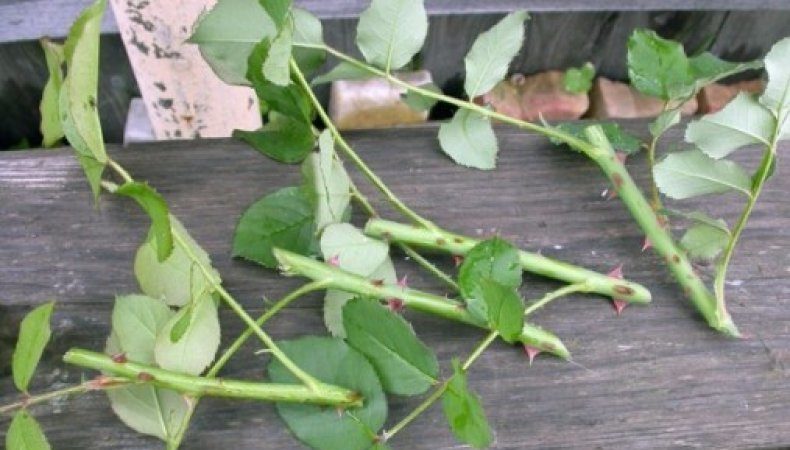
Cuttings are a method of propagation by cuttings. A stalk is a part of a living, healthy shoot of a certain length with several buds. It is cut from the mother plant and rooted in various ways: in water, earth, peat, moss, etc.
This method is very popular for the propagation of many flower, fruit, berry, ornamental crops. Experts advise using it due to the high survival rate of planting material and low labor intensity. Usually even inexperienced gardeners and gardeners can cope with cuttings.
Features of autumn cuttings of roses
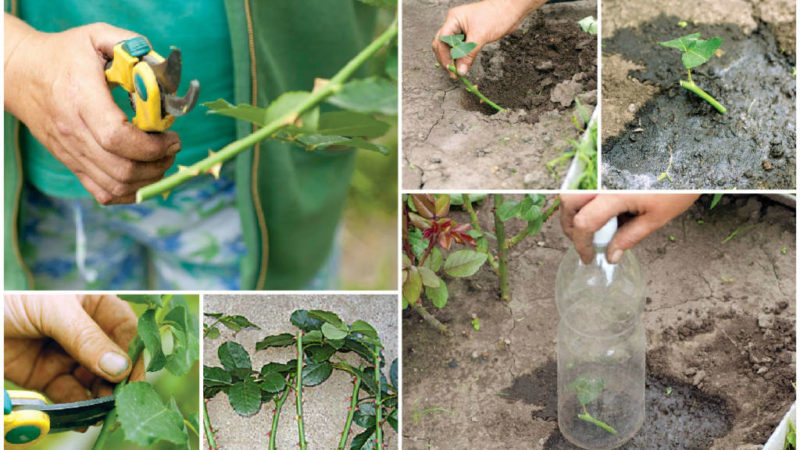
Autumn cuttings are considered a gentle breeding method. At this time of the year, all crops are preparing for a dormant period, vegetative processes slow down. In the spring, planting material prepared in the fall will quickly grow.
Advantages and disadvantages
The advantages of autumn cuttings of roses are enough:
- In the future, the bushes do not form wild growth. This gives them a more decorative look and greatly simplifies care.
- Plants are more hardy and frost-resistant than those rooted in spring. Even if the ground part of the bush freezes out in a harsh winter, it regenerates due to new shoots forming on the roots.
- It is not difficult to find planting material. You can take shoots cut during pre-winter formation, or root roses from a bouquet.
Some gardeners are skeptical about autumn cuttings of roses, claiming that the survival rate with this method is low. However, this becomes clear only in practice, since various factors influence here. One of them is a grade.
You should not cut hybrid tea, remontant and park roses. Better to choose:
- polyanthus;

- miniature;
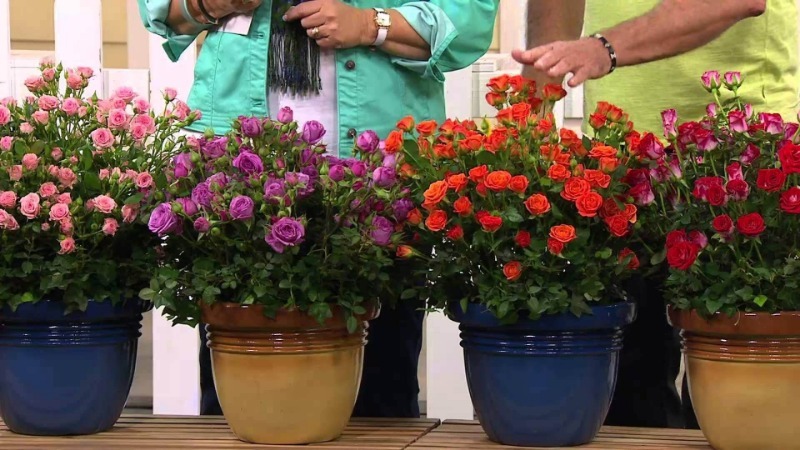
- climbing and semi-climbing;
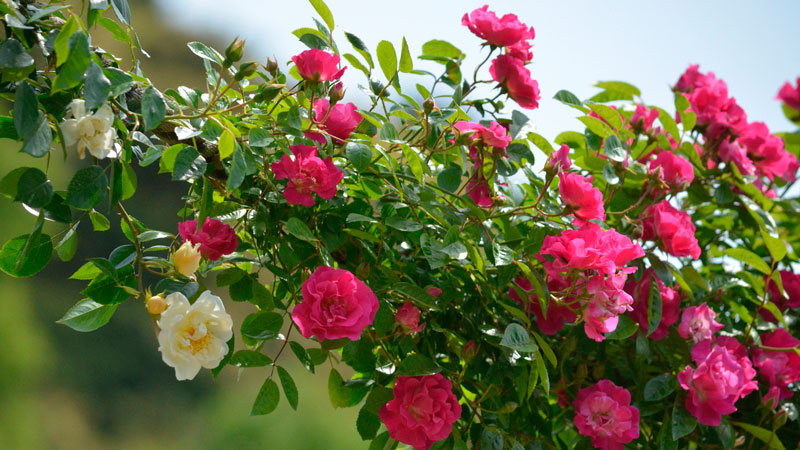
- from the Rambler group;
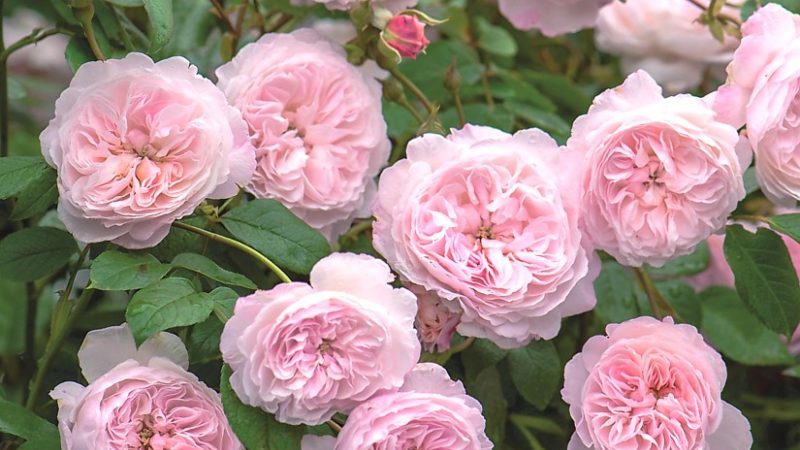
- Excels roses;

- varieties Flammentants, Iceberg, Rosalind.

Timing
The optimal dates for autumn cuttings of roses are late October or early November. The region also matters:
- in central Russia - October;
- in Siberia and the Urals - mid-September and early October;
- in the south - from late October to early November.
Another reference point is the air temperature: night readings - from -1 ° C to -3 ° C, daytime - about + 15 ° C.
How to properly cut roses in the fall at home
Cuttings are cut with a knife. Beforehand, it must be sharpened, washed, doused with boiling water and disinfected with alcohol.
Flowers from a bouquet

For cuttings, they take healthy, strong, not yet dried roses, so the flowers will have to be sacrificed.
Procedure:
- A flower is cut straight from the branch. The lower part is cut at an angle of 45 °.The middle one is divided into cuttings of 12-15 cm each. Each must have at least 3 healthy buds, the first should not be higher than 15 cm from the bottom cut, the last one 0.5 cm from the top.
- The lower leaves are removed. The upper ones are cut in half or 1/3.
- The upper cut is treated with a solution of potassium permanganate or burned with brilliant green.
- For a day, the cuttings are placed in a growth stimulator solution.
- The next day, the lower cut of the cuttings is sprinkled with a growth stimulator in the form of a powder and placed in a container with a special soil for roses at an angle of 45 °, deepening by 1.5-2 cm. The soil is watered with clean and warm water.
- A greenhouse is built on top - covered with a transparent bag or a cut-off plastic bottle.
- The containers are placed in a warm, well-lit place. Every day the greenhouse is removed for ventilation. Water only when the top layer of the soil dries up.
Reproduction of roses from a bouquet is not a very successful method. Of 10 cuttings, as a rule, only 2-3 take root.
From the bush

When grafting open-field rose bushes, the chances of success are higher. The planting material is initially stronger and healthier than that obtained from the bouquet. They work with him in the same way, but taking into account some nuances:
- Healthy shoots are cut from the bush and placed in a glass or jar of water. Greenhouse conditions are also created from above and the entire structure is placed under a fluorescent lamp.
- After a while, young shoots with reddish leaves form on the branches. When they turn dark green, the branches are cut into cuttings.
- They are placed in a growth stimulant solution. After 1.5-2 months, roots will appear.
- When they grow 1 cm, the cuttings are planted in the ground.
Rooting the cuttings in potatoes
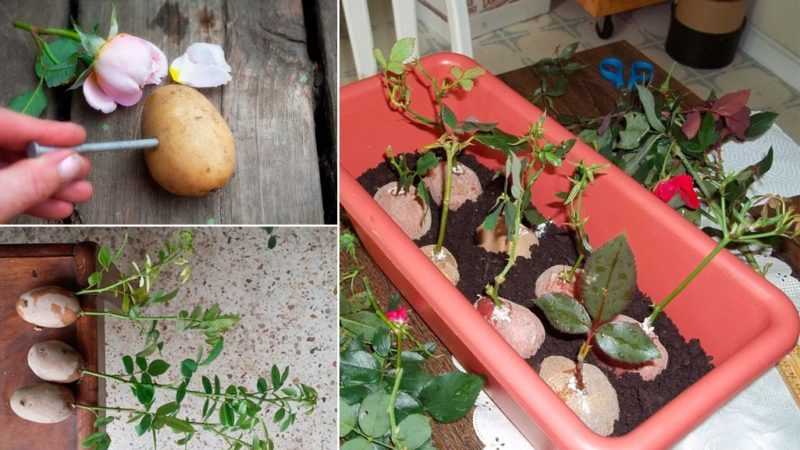
An alternative way is to root cuttings in potato tubers. The valuable substances in potatoes are believed to nourish roses.
Procedure:
- Fresh cuts of cuttings are treated with a weak solution of potassium permanganate and placed in a 1: 1 solution of aloe juice.
- After 12 hours, eyes are cut out of the potatoes and cuttings of roses are stuck into them.
- The tubers are placed in pots, covered with earth by 2/3 and watered with a dark solution of potassium permanganate.
- In conclusion, greenhouses are built over the pots - they are covered with transparent bags, cans or cut off plastic bottles. These greenhouses create a greenhouse effect that promotes rooting of cuttings.
- The pots are placed in a warm place where it is light, but not in direct sunlight.
- While the cuttings are rooting, they are watered with warm, settled water as the top layer of the soil dries out.
1 time in 5 days for watering use sweetened water (2 tsp sugar per 1 tbsp.). Sugar supports the vital functions of cuttings not yet rooted.
Attention! Many gardeners are skeptical about rooting rose cuttings in potatoes, and numerous reviews confirm the ineffectiveness of this method.
In the package
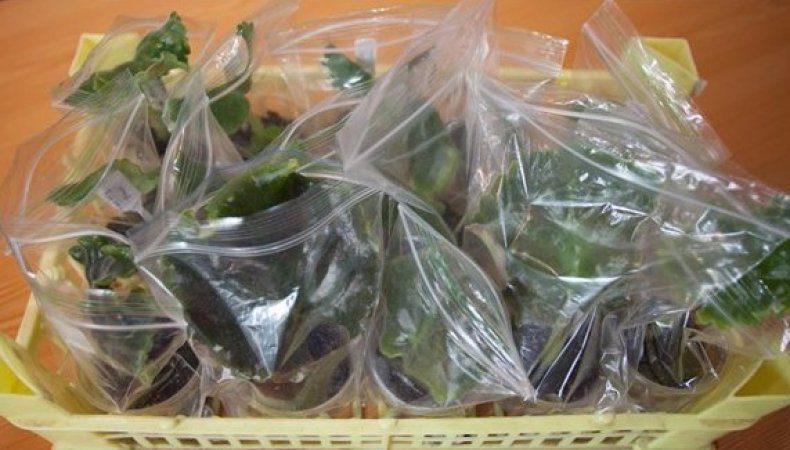
The method is based on the fact that a moist environment is constantly maintained around the cut of the cutting, where the roots should appear. A freshly cut rose stalk is wrapped at the base with wet moss (sold in gardening stores) and placed in a plastic bag, which is then inflated and tied. Just like the greenhouse in the above method, the bag is placed in a bright, warm place.
To increase the chances of success, moss can be moistened not with water, but with a solution of aloe juice (1 part juice to 9 parts water) or a growth stimulant. The effect should be expected in 3-4 weeks.
Burrito Method
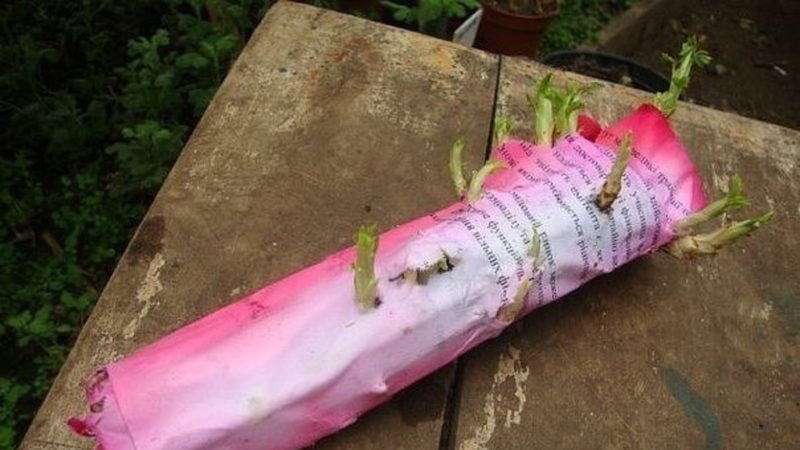
This method requires a minimum of effort, therefore it is suitable for inexperienced growers. However, the result is not 100% guaranteed.
Shoots for cuttings should be thicker than with other methods.
Algorithm:
- Cuttings are cut 20 cm long, all leaves are removed.
- Fresh sections are treated with a growth stimulant ("Epin" or "Kornevin").
- Then the cuttings are collected in a bunch, tied, wrapped in wet newspaper, put in a bag and put away this time in a dark, cool place (+ 15 ° C ... + 18 ° C).
The roots should form in about 2 weeks. All this time they make sure that the newspaper is wet and that the cuttings do not start to rot. If the outcome is successful, the roots will appear in 1.5 months.
Follow-up care

Drainage is poured into a small pot with a volume of about 200 ml with holes at the bottom about 1/4 - small pebbles, expanded clay, etc. Next, a special soil for roses is added, a stalk with roots is placed and watered with warm, settled water. Surplus should drain out through the drain holes.
Just like rooting, the planted shoots need greenhouse conditions. The pots are covered with clear cellophane bags, cut bottles or glass jars and placed on a warm, well-lit windowsill.
Every day the greenhouse is ventilated so that the air is renewed and the earth does not turn sour. After 2 weeks, the sprouts are gradually accustomed to new conditions, removing the shelter first for half an hour, then for an hour, etc. Within a week, the plants adapt and the greenhouses are dismantled.
Roses are watered under cover a little - as the topsoil dries up. Waterlogging in greenhouse conditions is dangerous - even rooted shoots can rot.
The appearance of young leaves suggests that it is time to feed the shoots with complexes of mineral and organic fertilizers for roses.
Attention! Buds may appear on young bushes. They should be cut off, otherwise the plants will put all their forces on them and will not develop either roots or the ground part.
During the dormant period - from late autumn to late winter - pink shoots also need good lighting, but a cool climate. They are protected from heat sources (radiators, heaters, etc.).
Timing and technology for transplanting cuttings into open ground
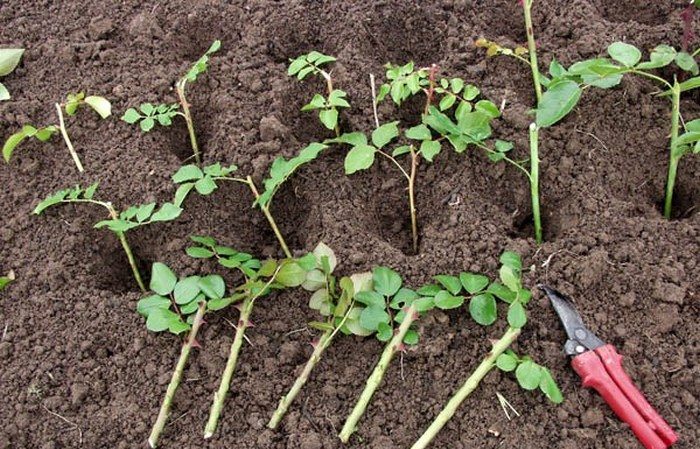
Cuttings rooted in the fall grow at home all winter. In the spring they are transplanted into the garden.
Roses love warmth and light, so on the site they choose a place for them that is protected from drafts and well lit, preferably from the south side. Well suited for this are flower beds along a fence, buildings or hedges. The soil should be loose, rich in organic fertilizers, without stagnant water.
Roses are transplanted into open ground by transshipment. The plant is carefully removed from the pot and, together with a lump of earth, placed in the hole. Given that the rose bushes grow very voluminous, the distance between the holes is made at least 50 cm. The bushes are sprinkled with earth at the base, mulched with humus and formed around the hole for rational watering.
Reference. To make a flower bed with roses look more aesthetically pleasing, it is better to plant the bushes not in rows, but in a checkerboard pattern.
Rooting cuttings immediately on the site

In order not to injure the plants with a spring transplant and free themselves from winter hassles, some gardeners practice rooting rose cuttings immediately in the open field. This is done a little earlier than when rooting at home - in the second half of September, no later than the 25th.
A place on the site is chosen as described above. They dig a furrow 30 cm deep, fill it 2/3 with grass and well-rotted compost. Roses are planted in a row at a distance of 15-20 cm from each other. The cuttings are stuck into the ground in the same way as when rooting in a pot - at an angle of 45 °, but at the same time only 2 upper buds are left on the surface, and 2 lower ones are buried in the ground. The soil is watered. In the future, it is moistened as it dries.
With the onset of cold snaps and the first frost, the cuttings are covered with jars and covered with grass or hay. You can make a common greenhouse for the entire flower bed by building a frame, covering it with plastic wrap and sprinkling it with earth around the edges. When frosts begin, such a greenhouse is completely covered with mulch, and during the winter - with snow. So the cuttings will successfully overwinter and will grow in the spring.
Read also:
Is it possible to grow petunia as a houseplant
Storing rose cuttings in winter until spring

Planting roses in spring is also popular. If the planting material has already been prepared, the question arises of how to preserve it in the winter so that it remains viable. How they do it:
- A small hole (about 15 cm deep) is dug in the garden or vegetable garden, the bottom and walls are covered with straw or peat and covered with cotton cloth or other covering material.
- Leaves are removed from prepared cuttings. The cuttings are laid out at the bottom of the hole at an equal distance from each other, carefully covered with the same material and sprinkled with earth.
- It is advisable to mark the edges of the fossa with pegs or twigs so that it is easy to find it in the spring.
When the snow melts in the spring, the cuttings are removed from the winter storage and examined. On viable ones, a peculiar growth is noticeable - callus. Later roots appear on it.
It is better to plant the extracted cuttings immediately. If they will wait for planting a day or more, it is recommended to put them in the water, adding a little "Epin".
Conclusion
Autumn cuttings (propagation by cuttings) are practiced much more often than grafting. Roses grown in this way take root well, grow both at home and in the open field. They are hardy and robust and, with proper care, delight the gardener with abundant and lush flowering.